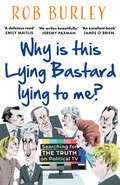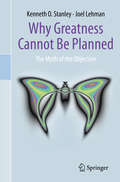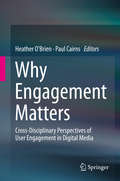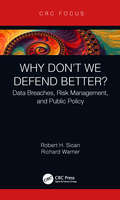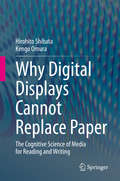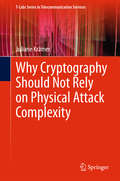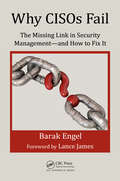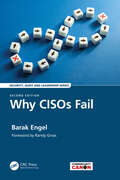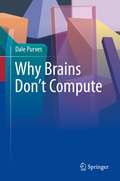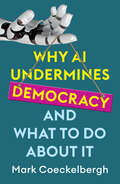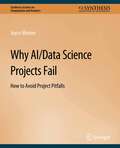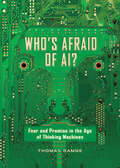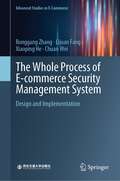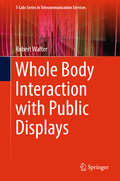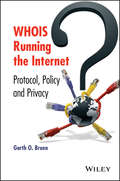- Table View
- List View
Why Is This Lying Bastard Lying to Me?: Searching For The Truth On Political Tv
by Rob BurleyA deliciously irreverent and humorous insider’s account of 25 years working at the very top of British political television ‘What Rob Burley doesn't know about political interviewing isn't worth knowing’ – Andrew Neil
Why Information Grows: The Evolution of Order, from Atoms to Economies
by César HidalgoIn Why Information Grows, rising star César Hidalgo offers a radical interpretation of global economicsWhile economists often turn to measures like GDP or per-capita income, César Hidalgo turns to information theory to explain the success or failure of a country's economic performance. Through a radical rethinking of what the economy is, Hidalgo shows that natural constraints in our ability to accumulate knowledge, knowhow and information explain the evolution of social and economic complexity. This is a rare tour de force, linking economics, sociology, physics, biology and information theory, to explain the evolution of social and economic systems as a consequence of the physical embodiment of information in a world where knowledge is quite literally power.César Hidalgo leads the Macro Connections group at the MIT Media Lab. A trained statistical physicist and an expert on Networks and Complex Systems, he also has extensive experience in the field of economic development and has pioneered research on how big data impacts economic decision-making.
Why Greatness Cannot Be Planned: The Myth of the Objective
by Kenneth O. Stanley Joel LehmanWhy does modern life revolve around objectives? From how science is funded, to improving how children are educated -- and nearly everything in-between -- our society has become obsessed with a seductive illusion: that greatness results from doggedly measuring improvement in the relentless pursuit of an ambitious goal. In Why Greatness Cannot Be Planned, Stanley and Lehman begin with a surprising scientific discovery in artificial intelligence that leads ultimately to the conclusion that the objective obsession has gone too far. They make the case that great achievement can't be bottled up into mechanical metrics; that innovation is not driven by narrowly focused heroic effort; and that we would be wiser (and the outcomes better) if instead we whole-heartedly embraced serendipitous discovery and playful creativity.Controversial at its heart, yet refreshingly provocative, this book challenges readers to consider life without a destination and discovery without a compass.
Why Fonts Matter
by Sarah HyndmanWe all constantly interact with type in almost every aspect of our lives. But how do fonts affect what we read and influence the choices we make?This book opens up the science and the art behind how fonts influence you. It explains why certain fonts or styles evoke particular experiences and associations. Fonts have different personalities that can create trust, mistrust, give you confidence, make things seem easier to do or make a product taste better. They’re hidden in plain sight, they trigger memories, associations and multisensory experiences in your imagination.* Fonts can alter the meanings of words right before your very eyes.* See what personalities fonts have, and what they reveal about YOUR personality.* Explore how you respond to fonts emotionally and can make fonts work for your message.* Be amazed that a font has the power to alter the taste of your food.This book is for anyone who is interested in giving words impact, who loves words and how they influence us.
Why Engagement Matters: Cross-Disciplinary Perspectives of User Engagement in Digital Media
by Heather O'Brien Paul CairnsUser Engagement (UE) is a complex concept to investigate. The purpose of this book is not to constrain UE to one perspective, but to offer a well-rounded appreciation for UE across various domains and disciplines. The text begins with two foundational chapters that describe theoretical and methodological approaches to user engagement; the remaining contributions examine UE from different disciplinary perspectives and across a range of computer-mediated environments, including social and communications media, online search, eLearning, games, and eHealth. The book concludes by bringing together the cross-disciplinary perspectives presented in each chapter and proposing an agenda for future research in this area. The book will appeal to established and emerging academic and industry researchers looking to pursue research and its challenges. This includes scholars at all levels with an interest in user engagement with digital media, from students to experienced researchers, and professionals in the fields of computer science, web technology, information science, museum studies, learning and health sciences, human-computer interaction, information architecture and design, and creative arts.
Why Don't We Defend Better?: Data Breaches, Risk Management, and Public Policy
by Robert H. Sloan Richard WarnerThe wave of data breaches raises two pressing questions: Why don’t we defend our networks better? And, what practical incentives can we create to improve our defenses? Why Don't We Defend Better?: Data Breaches, Risk Management, and Public Policy answers those questions. It distinguishes three technical sources of data breaches corresponding to three types of vulnerabilities: software, human, and network. It discusses two risk management goals: business and consumer. The authors propose mandatory anonymous reporting of information as an essential step toward better defense, as well as a general reporting requirement. They also provide a systematic overview of data breach defense, combining technological and public policy considerations. Features Explains why data breach defense is currently often ineffective Shows how to respond to the increasing frequency of data breaches Combines the issues of technology, business and risk management, and legal liability Discusses the different issues faced by large versus small and medium-sized businesses (SMBs) Provides a practical framework in which public policy issues about data breaches can be effectively addressed
Why Don't We Defend Better?: Data Breaches, Risk Management, and Public Policy
by Robert H. Sloan Richard WarnerThe wave of data breaches raises two pressing questions: Why don’t we defend our networks better? And, what practical incentives can we create to improve our defenses? Why Don't We Defend Better?: Data Breaches, Risk Management, and Public Policy answers those questions. It distinguishes three technical sources of data breaches corresponding to three types of vulnerabilities: software, human, and network. It discusses two risk management goals: business and consumer. The authors propose mandatory anonymous reporting of information as an essential step toward better defense, as well as a general reporting requirement. They also provide a systematic overview of data breach defense, combining technological and public policy considerations. Features Explains why data breach defense is currently often ineffective Shows how to respond to the increasing frequency of data breaches Combines the issues of technology, business and risk management, and legal liability Discusses the different issues faced by large versus small and medium-sized businesses (SMBs) Provides a practical framework in which public policy issues about data breaches can be effectively addressed
Why Digital Displays Cannot Replace Paper: The Cognitive Science of Media for Reading and Writing
by Hirohito Shibata Kengo OmuraFrom readability to operability, this book presents a number of experiments to analyze the characteristics of paper and digital displays in reading and writing. Why is it easy to read on paper? Why is it easy to concentrate on reading on paper? Why is it easy to think while writing or drawing on paper? This book answers these questions based on cognitive experiments on media. Paper is easy to read because it is easy to handle. If we emphasize the strengths of paper, paper is an operation media rather than a presentation media. These experiments also indicate how to develop digital media for reading and writing.This book will interest those who want to gain a scientific understanding of reading and writing on paper, those who want to work more effectively by selectively using paper and digital tools (e.g. knowledge workers and educators), and those who develop digital devices or services for reading and writing.
Why Cryptography Should Not Rely on Physical Attack Complexity (T-Labs Series in Telecommunication Services)
by Juliane KrämerThis book presents two practical physical attacks. It shows how attackers can reveal the secret key of symmetric as well as asymmetric cryptographic algorithms based on these attacks, and presents countermeasures on the software and the hardware level that can help to prevent them in the future. Though their theory has been known for several years now, since neither attack has yet been successfully implemented in practice, they have generally not been considered a serious threat. In short, their physical attack complexity has been overestimated and the implied security threat has been underestimated. First, the book introduces the photonic side channel, which offers not only temporal resolution, but also the highest possible spatial resolution. Due to the high cost of its initial implementation, it has not been taken seriously. The work shows both simple and differential photonic side channel analyses. Then, it presents a fault attack against pairing-based cryptography. Due to the need for at least two independent precise faults in a single pairing computation, it has not been taken seriously either.Based on these two attacks, the book demonstrates that the assessment of physical attack complexity is error-prone, and as such cryptography should not rely on it. Cryptographic technologies have to be protected against all physical attacks, whether they have already been successfully implemented or not. The development of countermeasures does not require the successful execution of an attack but can already be carried out as soon as the principle of a side channel or a fault attack is sufficiently understood.
Why CISOs Fail: The Missing Link in Security Management--and How to Fix It (Internal Audit and IT Audit)
by Barak EngelThis book serves as an introduction into the world of security and provides insight into why and how current security management practices fail, resulting in overall dissatisfaction by practitioners and lack of success in the corporate environment. The author examines the reasons and suggests how to fix them. The resulting improvement is highly beneficial to any corporation that chooses to pursue this approach or strategy and from a bottom-line and business operations perspective, not just in technical operations. This book transforms the understanding of the role of the CISO, the selection process for a CISO, and the financial impact that security plays in any organization.
Why CISOs Fail: The Missing Link in Security Management--and How to Fix It (Internal Audit and IT Audit)
by Barak EngelThis book serves as an introduction into the world of security and provides insight into why and how current security management practices fail, resulting in overall dissatisfaction by practitioners and lack of success in the corporate environment. The author examines the reasons and suggests how to fix them. The resulting improvement is highly beneficial to any corporation that chooses to pursue this approach or strategy and from a bottom-line and business operations perspective, not just in technical operations. This book transforms the understanding of the role of the CISO, the selection process for a CISO, and the financial impact that security plays in any organization.
Why CISOs Fail (Security, Audit and Leadership Series)
by Barak EngelReleased in 2017, the first edition of Why CISOs Fail reimagined the role of the Chief Information Security Officer in a new and powerful way. Written to be easily consumable by both security pros as well as everyone who must deal with them, the book explores the different realms in which security leaders fail to deliver meaningful impact to their organizations, and why this happens. Its central thesis—that security is primarily a human behavioral discipline rather than a technology one—has been gaining increased attention as a core tenet of the field, and the book was ultimately inducted into the cybersecurity canon as a leading book on security management.In this freshly updated edition, Barak Engel adds new sections that correspond with the chapters of the original book: security as a discipline; as a business enabler; in sales; in legal; in compliance; in technology; and as an executive function. He explores new ideas in each operational area, providing essential insights into emerging aspects of the discipline. He then proposes two critical concepts for security management—the concept of "digital shrinkage" and the transition from CISO to CI/SO—that together offer a new paradigm for any organization that wants to become truly successful in its security journey.Why CISOs (Still) Fail is delivered in Barak's conversational, humoristic style, that has attracted a global audience to this and his other book, The Security Hippie. As he notes, the book's goal is to entertain as much as to inform, and he dearly hopes that you have fun reading it.
Why CISOs Fail: The Missing Link In Security Management--and How To Fix It (Security, Audit and Leadership Series)
by Barak EngelReleased in 2017, the first edition of Why CISOs Fail reimagined the role of the Chief Information Security Officer in a new and powerful way. Written to be easily consumable by both security pros as well as everyone who must deal with them, the book explores the different realms in which security leaders fail to deliver meaningful impact to their organizations, and why this happens. Its central thesis—that security is primarily a human behavioral discipline rather than a technology one—has been gaining increased attention as a core tenet of the field, and the book was ultimately inducted into the cybersecurity canon as a leading book on security management.In this freshly updated edition, Barak Engel adds new sections that correspond with the chapters of the original book: security as a discipline; as a business enabler; in sales; in legal; in compliance; in technology; and as an executive function. He explores new ideas in each operational area, providing essential insights into emerging aspects of the discipline. He then proposes two critical concepts for security management—the concept of "digital shrinkage" and the transition from CISO to CI/SO—that together offer a new paradigm for any organization that wants to become truly successful in its security journey.Why CISOs (Still) Fail is delivered in Barak's conversational, humoristic style, that has attracted a global audience to this and his other book, The Security Hippie. As he notes, the book's goal is to entertain as much as to inform, and he dearly hopes that you have fun reading it.
Why Brains Don't Compute
by Dale PurvesThis book examines what seems to be the basic challenge in neuroscience today: understanding how experience generated by the human brain is related to the physical world we live in. The 25 short chapters present the argument and evidence that brains address this problem on a wholly trial and error basis. The goal is to encourage neuroscientists, computer scientists, philosophers, and other interested readers to consider this concept of neural function and its implications, not least of which is the conclusion that brains don’t “compute.”
WHY AREN'T WE TALKING ABOUT THIS?!: An Inclusive Illustrated Guide to Life in 100+ Questions
by Hazel Mead'Informative and bold' Dr Karen Gurney | 'Compassionate, artistic, tasteful' Joshua FletcherWhat is the most personal thing you've asked the Internet? Illustrator Hazel Mead turns to Google to uncover what we secretly ask search bars about our relationships, bodies and identities. With hundreds of demystifying and empowering illustrations, she offers a fun, shame-free and inclusive guide to life's big questions. This is the emotional curriculum you'll wish was taught in every classroom.What if there was a book that explored the big lessons of life? Sure, formal education will equip you with requisite knowledge on photosynthesis. But when it comes to spotting the green flags in a prospective partner, navigating yours or a loved one's grief, knowing how to prepare for a cervical screening, or to practicing self-defense, it can feel like total guesswork.Using the latest research, interviews with experts, and her signature visuals, Hazel interrogates the taboos that shame us into silence. Since the answers to life's big questions are rarely black and white, she answers them in colour, with accessible design and compassionate reflections. Why Aren't We Talking About This?! is an exploration of the things we're too afraid to ask but desperately need to know and talk about for greater acceptance of others and ourselves. It's a bold invitation to forget normal and embrace what makes you unique.
Why AI Undermines Democracy and What To Do About It
by Mark CoeckelberghAcross the world, AI is used as a tool for political manipulation and totalitarian repression. Stories about AI are often stories of polarization, discrimination, surveillance, and oppression. Is democracy in danger? And can we do anything about it? In this compelling and balanced book, Mark Coeckelbergh reveals the key risks posed by AI for democracy. He argues that AI, as currently used and developed, undermines fundamental principles on which liberal democracies are founded, such as freedom and equality. How can we make democracy more resilient in the face of AI? And, more positively, what can AI do for democracy? Coeckelbergh advocates not only for more democratic technologies, but also for new political institutions and a renewal of education to ensure that AI promotes, rather than hinders, the common good for the twenty-first century. Why AI Undermines Democracy and What to Do About It is illuminating reading for anyone who is concerned about the fate of democracy.
Why AI/Data Science Projects Fail: How to Avoid Project Pitfalls (Synthesis Lectures on Computation and Analytics)
by Joyce WeinerRecent data shows that 87% of Artificial Intelligence/Big Data projects don’t make it into production (VB Staff, 2019), meaning that most projects are never deployed. This book addresses five common pitfalls that prevent projects from reaching deployment and provides tools and methods to avoid those pitfalls. Along the way, stories from actual experience in building and deploying data science projects are shared to illustrate the methods and tools. While the book is primarily for data science practitioners, information for managers of data science practitioners is included in the Tips for Managers sections.
Who's Afraid of AI?: Fear and Promise in the Age of Thinking Machines
by Thomas RamgeA penetrating guide to artificial intelligence: what it is, what it does, and how it will change our lives At a breathtaking pace, artificial intelligence is getting better and faster at making complex decisions. AI can already identify malignant tumors on CT scans, give legal advice, out-bluff the best poker players in the world, and, with ever-increasing skill, drive our cars. In Who&’s Afraid of AI?, award-winning author Thomas Ramge expertly explains how machines are learning to learn, and he questions what today&’s explosion of AI capability could mean for tomorrow: Is it ethical to allow robots—endlessly patient—to replace human caregivers in providing comfort and companionship to the elderly?Since AI feeds on big data, can we prevent its misuse by corporations or the government?Will AI ever be capable of runaway self-improvement? And if &“the singularity&” does arrive, with AI&’s intelligence exponentially outpacing our own, what will become of us when, in many ways, we&’re obsolete?
Who's #1?: The Science of Rating and Ranking
by Amy N. Langville Carl D. MeyerA website's ranking on Google can spell the difference between success and failure for a new business. NCAA football ratings determine which schools get to play for the big money in postseason bowl games. Product ratings influence everything from the clothes we wear to the movies we select on Netflix. Ratings and rankings are everywhere, but how exactly do they work? Who's #1? offers an engaging and accessible account of how scientific rating and ranking methods are created and applied to a variety of uses. Amy Langville and Carl Meyer provide the first comprehensive overview of the mathematical algorithms and methods used to rate and rank sports teams, political candidates, products, Web pages, and more. In a series of interesting asides, Langville and Meyer provide fascinating insights into the ingenious contributions of many of the field's pioneers. They survey and compare the different methods employed today, showing why their strengths and weaknesses depend on the underlying goal, and explaining why and when a given method should be considered. Langville and Meyer also describe what can and can't be expected from the most widely used systems. The science of rating and ranking touches virtually every facet of our lives, and now you don't need to be an expert to understand how it really works. Who's #1? is the definitive introduction to the subject. It features easy-to-understand examples and interesting trivia and historical facts, and much of the required mathematics is included.
Who's #1?: The Science of Rating and Ranking
by Amy N. Langville Carl D. MeyerA website's ranking on Google can spell the difference between success and failure for a new business. NCAA football ratings determine which schools get to play for the big money in postseason bowl games. Product ratings influence everything from the clothes we wear to the movies we select on Netflix. Ratings and rankings are everywhere, but how exactly do they work? Who's #1? offers an engaging and accessible account of how scientific rating and ranking methods are created and applied to a variety of uses. Amy Langville and Carl Meyer provide the first comprehensive overview of the mathematical algorithms and methods used to rate and rank sports teams, political candidates, products, Web pages, and more. In a series of interesting asides, Langville and Meyer provide fascinating insights into the ingenious contributions of many of the field's pioneers. They survey and compare the different methods employed today, showing why their strengths and weaknesses depend on the underlying goal, and explaining why and when a given method should be considered. Langville and Meyer also describe what can and can't be expected from the most widely used systems. The science of rating and ranking touches virtually every facet of our lives, and now you don't need to be an expert to understand how it really works. Who's #1? is the definitive introduction to the subject. It features easy-to-understand examples and interesting trivia and historical facts, and much of the required mathematics is included.
The Whole Process of E-commerce Security Management System: Design and Implementation (Advanced Studies in E-Commerce)
by Ronggang Zhang Lijuan Fang Xiaoping He Chuan WeiThis book systematically and integrally introduces the new security management theories and methods in the e-commerce environment. Based on the perspective of dynamic governance of the whole process, starting from the theoretical framework, this book analyzes the gap between the current situation and requirements of security management, defines its nature, function, object and system, and designs and constructs the whole process security management organization and operation system of e-commerce. It focuses on the core and most prominent risk control links (i.e. security impact factors) in e-commerce security, including e-commerce information and network security risk, e-commerce transaction risk, e-commerce credit risk, e-commerce personnel risk, etc. Then, the tools and methods for identifying and controlling various risks are described in detail, at the same time, management decision-making and coordination are integrated into the risk management. Finally, a closed loop of self-optimization is established by a continuous optimization evolution path of e-commerce security management.
Whole Body Interaction with Public Displays (T-Labs Series in Telecommunication Services)
by Robert WalterThis book develops valuable new approaches to digital out-of-home media and digital signage in urban environments. It offers solutions for communicating interactive features of digital signage to passers-by. Digital out-of-home media and digital signage screens are becoming increasingly interactive thanks to touch input technology and gesture recognition. To optimize their conversion rate, interactive public displays must 1) attract attention, 2) communicate to passers-by that they are interactive, 3) explain the interaction, and 4) provide a motivation for passers-by to interact.This book highlights solutions to problems 2 and 3 above. The focus is on whole-body interaction, where the positions and orientations of users and their individual body parts are captured by specialized sensors (e.g., depth cameras). The book presents revealing findings from a field study on communicating interactivity, a laboratory on analysing visual attention, a field study on mid-air gestures, and a field study on using mid-air gestures to select items on interactive public displays.
Whole Body Interaction (Human–Computer Interaction Series)
by David EnglandWhole Body Interaction is “The integrated capture and processing of human signals from physical, physiological, cognitive and emotional sources to generate feedback to those sources for interaction in a digital environment” (England 2009).Whole Body Interaction looks at the challenges of Whole Body Interaction from the perspectives of design, engineering and research methods. How do we take physical motion, cognition, physiology, emotion and social context to push boundaries of Human Computer Interaction to involve the complete set of human capabilities? Through the use of various applications the authors attempt to answer this question and set a research agenda for future work.Aimed at students and researchers who are looking for new project ideas or to extend their existing work with new dimensions of interaction.
Whole-Body Impedance Control of Wheeled Humanoid Robots (Springer Tracts in Advanced Robotics #116)
by Alexander DietrichIntroducing mobile humanoid robots into human environments requires the systems to physically interact and execute multiple concurrent tasks. The monograph at hand presents a whole-body torque controller for dexterous and safe robotic manipulation. This control approach enables a mobile humanoid robot to simultaneously meet several control objectives with different pre-defined levels of priority, while providing the skills for compliant physical contacts with humans and the environment. After a general introduction into the topic of whole-body control, several essential reactive tasks are developed to extend the repertoire of robotic control objectives. Additionally, the classical Cartesian impedance is extended to the case of mobile robots. All of these tasks are then combined and integrated into an overall, priority-based control law. Besides the experimental validation of the approach, the formal proof of asymptotic stability for this hierarchical controller is presented. By interconnecting the whole-body controller with an artificial intelligence, the immense potential of the integrated approach for complex real-world applications is shown. Several typical household chores, such as autonomously wiping a window or sweeping the floor with a broom, are successfully performed on the mobile humanoid robot Rollin’ Justin of the German Aerospace Center (DLR). The results suggest the presented controller for a large variety of fields of application such as service robotics, human-robot cooperation in industry, telepresence in medical applications, space robotics scenarios, and the operation of mobile robots in dangerous and hazardous environments.
WHOIS Running the Internet: Protocol, Policy, and Privacy
by Garth O. BruenDiscusses the evolution of WHOIS and how policy changes will affect WHOIS’ place in IT today and in the futureThis book provides a comprehensive overview of WHOIS. The text begins with an introduction to WHOIS and an in-depth coverage of its forty-year history. Afterwards it examines how to use WHOIS and how WHOIS fits in the overall structure of the Domain Name System (DNS). Other technical topics covered include WHOIS query code and WHOIS server details. The book also discusses current policy developments and implementations, reviews critical policy documents, and explains how they will affect the future of the Internet and WHOIS. Additional resources and content updates will be provided through a supplementary website. Includes an appendix with information on current and authoritative WHOIS services around the world Provides illustrations of actual WHOIS records and screenshots of web-based WHOIS query interfaces with instructions for navigating them Explains network dependencies and processes related to WHOIS utilizing flowcharts Contains advanced coding for programmers Visit the book's companion website http://whois.knujon.com for technical and policy documents concerning WHOIS, WHOIS code examples, internet locations for WHOIS databases and more. WHOIS Running the Internet: Protocol, Policy, and Privacy is written primarily for internet developers, policy developers, industry professionals in law enforcement, digital forensic investigators, and intellectual property attorneys.Garth O. Bruen is an Internet policy and security researcher whose work has been published in the Wall Street Journal and the Washington Post. Since 2012 Garth Bruen has served as the North American At-Large Chair to the Internet Corporation of Assigned Names and Numbers (ICANN). In 2003 Bruen created KnujOn.com with his late father, Dr. Robert Bruen, to process and investigate Internet abuse complaints (SPAM) from consumers. Bruen has trained and advised law enforcement at the federal and local levels on malicious use of the Domain Name System in the way it relates to the WHOIS record system. He has presented multiple times to the High Technology Crime Investigation Association (HTCIA) as well as other cybercrime venues including the Anti-Phishing Working Group (APWG) and the National Center for Justice and the Rule of Law at The University of Mississippi School of Law. Bruen also teaches the Fisher College Criminal Justice School in Boston where he develops new approaches to digital crime.
